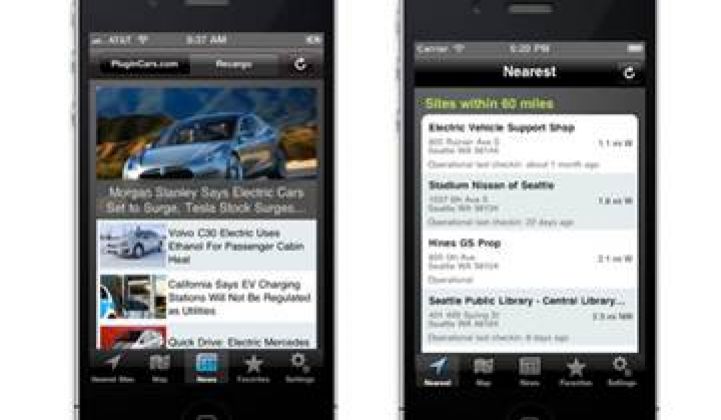The electric vehicle (EV) charging station finder provided through internet entrepreneur Brian Kariger's Recargo iPhone app is so state-of-the-art that Nissan recently suggested on its Facebook page that LEAF owners use it: "[C]onsider adding Recargo to your smartphone,” read their Facebook entry. “The latest upgrade to the app features Google Street Views to help you locate charging stations easier.”
Until charging stations become as common as gas stations, knowing where chargers are available is vital to even veteran EV drivers. For potential new drivers, who polls show are in the minority of the car-buying public by about 55 percent to 45 percent , it could be key to alleviating the much-ballyhooed problem of range anxiety.
Recargo’s endorsement from Nissan jumps it ahead in the competition to be the go-to charger finder service. Charger makers such as ECOtatlity and Coulomb Technologies have services for their own products. CarStations and Xatori have open source services that are reportedly not as developed.
Though there is a Recargo (Spanish for recharge) website, its greatest value is as an iPhone app because its most important service is providing up-to-the-minute information about where charging stations are and how they are performing, information that many EV drivers are already finding they don't want to leave home without.
Beyond Recargo’s Google Earth maps and Street Views, there is another screen with site details, including directions to the charging station, pictures of the charging station submitted by other users, and reports on charging station functionality based on recent user visits.
That screen also offers EV drivers the opportunity to take and submit pictures and text updates. “Everything in the app,” Kariger said, “is live information.”
Another screen lists the kinds of chargers available at each station and allows a search filtered by charger preference. Another, in partnership with Plug-In News, delivers EV news items.
Kariger conceived Recargo while driving a Tesla he bought in 2006. “It was a case of thinking, ‘There are ways we could enhance the experience,’” he remembered.
EV pioneer Tom Dowling created the first charger finder maps for EVChargerNews, which the U.S. Department of Energy uses on its charger finder website. Recargo, with Dowling’s consent, also uses those maps, but extends their value through feedback that Kariger sought out from EV users.
User feedback, Kariger had discovered as creator of the popular Dictionary.com and Thesaurus.com websites, is what makes a site successful and useful. “Integrating customer insights into the application is key for us,” Kariger said.
The Recargo iPhone app takes user input to a new level by allowing users everywhere to provide ongoing updates about charging stations by text and picture directly from their phones while they are using the service.
“A lot of places will give you a White Pages address,” Kariger explained. “Once you’re there, you still need to find out how to get to the charger. LAX has twelve or more chargers, but you need to know which lot they’re in, and once you’re in the lot, do you turn right or left and on which level?” Recargo makes answering those questions easier.
Kariger created the website and the app between the end of 2009 and the middle of 2010. This put him ahead of the first big wave of EV purchasers that came when the Leaf and General Motors’ Chevrolet Volt went into showrooms in late 2010.
“It took some patience,” Kariger said of the time he waited for the cars to meet the buying public, “but it was important to get out and get some feedback from early adopters so when the time came to scale up to thousands and tens of thousands more, we would be ready.”
From the several thousand new EV drivers that have emerged since the showroom rollout, Kariger got more feedback for the newest version of the app. “Membership is up 18 percent and member contributions are up 23 percent,” he said of the response to Recargo 1.5. It has also become the only charger finder app to generate advertising revenue and Kariger has received buy-in offers.
Non-iPhone users can access the website from their smartphones’ browsers, but there is no app tailored specifically for other systems -- yet. “Android and Blackberry are certainly taking off,” Kariger said, “and we’re paying attention.”
Recargo also offers some insight into how many places still have few chargers. A query in California might produce a long list of chargers within 100 miles, but a similar query for a Midwestern state might turn up only two.
“We provide an antidote to the anxiety you might have with driving around and not knowing where a charging station is,” Kariger said. “But the intent is to accelerate the building of a charging infrastructure so there is no need for this information.”
That will not put Recargo out of business. Like so many others in the EV community that Recargo now serves, Kariger is looking beyond today. For the foreseeable future, there will be the opportunity to link economic activity with charging stops and destinations, and Recargo is positioning itself to be part of that.
“We have a broader mission,” Kariger said, “of working on applications for people with connected cars. That’s the next level. Newer-generation cars have telematics, with a built-in computer connected to the internet in real time.” It is a considerably bigger opportunity than a charger finder service. “We’re just getting started,” said Kariger.



